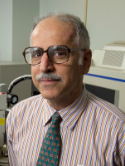| Abstract: |
Abstract— The relative biological importance of cis‐syn cyclobutane dimer and pyrimidine(6–4)pyr‐imidone photoadduct ([6–4] photoadduct) appears to be dependent on the biological species, dipyrimidine sites and the local conformational variation induced at the damaged sites. The single‐stranded deoxyn‐ucleotide 10‐mers containing the site‐specific (6–4) adduct or cis‐syn cyclobutane dimer of thymidylyl (3'‐5')‐thymidine were generated by direct photolysis of d(CGCATTACGC) with UVC (220–260 nm) irradiation or UVB (260–320 nm) photosensitization. Three‐dimensional structures of the duplex cis‐syn and (6–4) decamers of d(CGCATTACGC)d(GCGTAATGCG) were determined by NMR spectroscopy and the relaxation matrix refinement method. The NMR data and structural calculations establish that Watson‐Crick base pairing is still intact at the cis‐syn dimer site while the hydrogen bonding is absent at the 3'‐side of the (6–4) lesion where the T → C transition mutation is predominantly targeted. Overall conformation of the duplex cis‐syn decamer was B‐DNA and produced a 9° bending in the DNA helix, but a distinctive base orientation of the (6–4) lesion provided a structural basis leading to 44° helical bending. The observed local structure and conformational rigidity at the (6–4) adduct of the thymidylyl(3'‐5')‐thymidine (T‐T [6–4]) lesion site suggest the potential absence of hydrogen bonding at the 3' sides of the (6–4) lesion with a substituted nucleotide during replication under SOS conditions. Contrasting structural distortions induced by the T‐T (6–4) adduct with respect to the T‐T cis‐syn cyclobutane pyrimidine photodimer may explain the large differences in mutation spectrum and repair activities between them. Copyright © 1995, Wiley Blackwell. All rights reserved |



